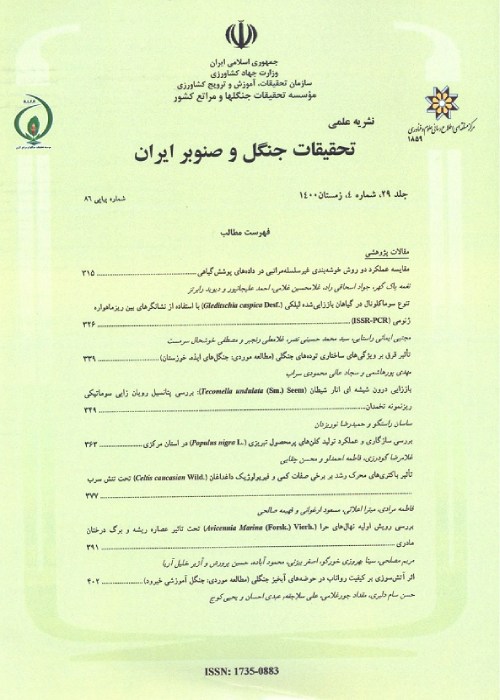Qualitative investigation of Gall Oak (Quercus infectoria Oliv.) acorns in untouched and pruned forest stands of Baneh (Kurdistan province, N-W Iran)
Author(s):
Abstract:
Due to encroachment and intense utilization, natural ecosystems of Zagros lost their normal trend and have converted to fragile and sensitive ecosystems. There are dense human populations that live in these forests which are depended on these forest resources. One of the most important utilizations in northern Zagros is Galazani (pruning) and using of oak limbs as fodder. This kind of use leads to prominent changes in forest structure and its physiognomy in some region (for example Alot in Kurdistan province) which can be a hazard for forest sustainability. Regarding to this problem and having no regeneration from seed, qualitative characteristics of Gall oak acorns, that is one of the most prominent species in these forests, was investigated in three untouched and pruned sites. Totally 60 Gall-oak trees (10 trees per site) and 6000 acorns (100 acorns per tree) were collected. Primary moisture of acorns in untouched sites was a little more than in pruned sites but there was no significant difference between them. The weevil Curculio gladium and Balaninus gladium were the insect species that predated the acorns collected from our sites. There were significant difference (in level of 95%) in the infestation rate among untouched and pruned sites of Blake, however in Ghole-shir and Mir-Yousef sites were no significant differences between insect-infested acorns. The weight of thousand acorns was significantly more in untouched sites; probably because of having more time to storing enough nutrients in their cotyledons. Germination percent and germination index data were analyzed by simple One Way ANOVA, and their averages were compared by Duncan test. There were no significant differences between germination percent of untouched and pruned sites. Comparing means indicate that, Blake site with 96.75 germination percent was placed in group A, Ghole-shir and Mir-Yousef sites were placed in group B with 90.78 and 88.75 germination percent, respectively. Germination index of untouched and pruned sites had no significant differences and in Duncan grouping they placed in one group. The values for germination index in Mir-Yousef, Blake and Ghole-shir sites were 13.18, 12.83 and 12.36, respectively.
Keywords:
Language:
Persian
Published:
Iranian Journal of Forest and Poplar Research, Volume:16 Issue: 1, 2008
Page:
99
magiran.com/p531696
دانلود و مطالعه متن این مقاله با یکی از روشهای زیر امکان پذیر است:
اشتراک شخصی
با عضویت و پرداخت آنلاین حق اشتراک یکساله به مبلغ 1,390,000ريال میتوانید 70 عنوان مطلب دانلود کنید!
اشتراک سازمانی
به کتابخانه دانشگاه یا محل کار خود پیشنهاد کنید تا اشتراک سازمانی این پایگاه را برای دسترسی نامحدود همه کاربران به متن مطالب تهیه نمایند!
توجه!
- حق عضویت دریافتی صرف حمایت از نشریات عضو و نگهداری، تکمیل و توسعه مگیران میشود.
- پرداخت حق اشتراک و دانلود مقالات اجازه بازنشر آن در سایر رسانههای چاپی و دیجیتال را به کاربر نمیدهد.
In order to view content subscription is required
Personal subscription
Subscribe magiran.com for 70 € euros via PayPal and download 70 articles during a year.
Organization subscription
Please contact us to subscribe your university or library for unlimited access!


